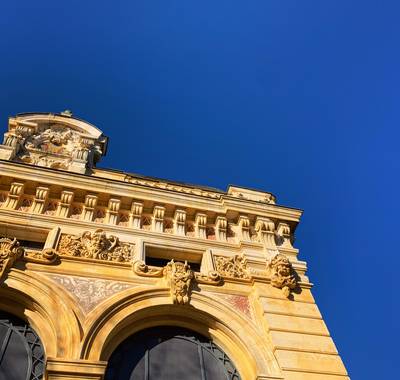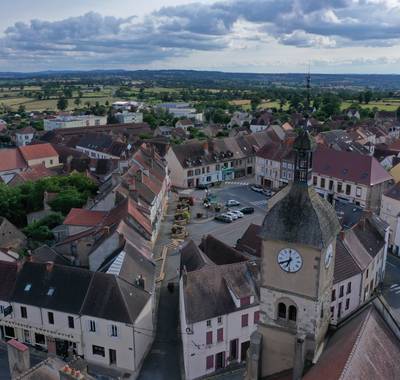"For spa-goers, tourists, locals and anyone else who wants to look after their well-being, for those who need peace and quiet, comfort and reassurance and a diverse range of tourist attractions, this small area, full of little treasures, is a tourist destination in its own right!
The pretty town of Néris-les-Bains, Commentry, Montmarault and Cosne-d'Allier offer a full range of tourist facilities, including thermal baths, spas, hotels, campsites, restaurants and a casino, as well as top-quality cultural and events venues including the André Messager Theatre and the Agora.
In the green countryside of the Bourbonnais, a land of history and castles, there are plenty of opportunities for walking and cycling."
Well-being inspirations in the Bourbonnais
Our "Inspirations for well-being in the Bourbonnais" can be enjoyed at the pace of your choice:
- Contemplative, if you like to be impressed by the colours and gentle shapes of the countryside, and by the heritage on a stroll through villages and towns.
- Active, even sporty, if you want to do your body good in authentic landscapes that are gentle and rounded, soothing and beneficial: walking or mountain biking, golf, orienteering, etc.
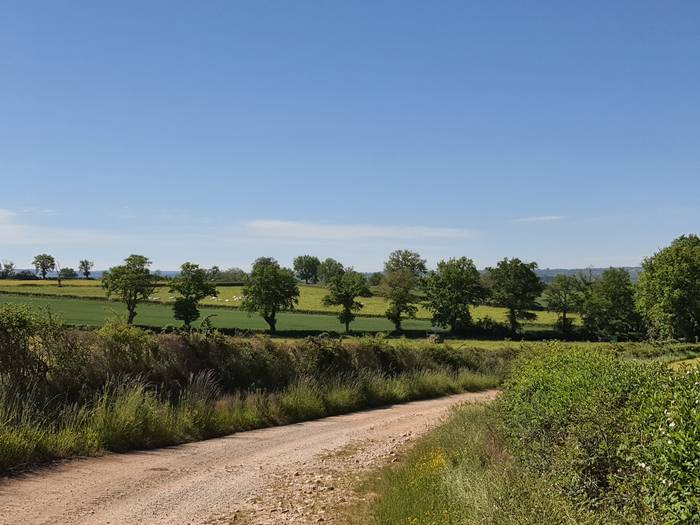
1, 2, 3 ideas!
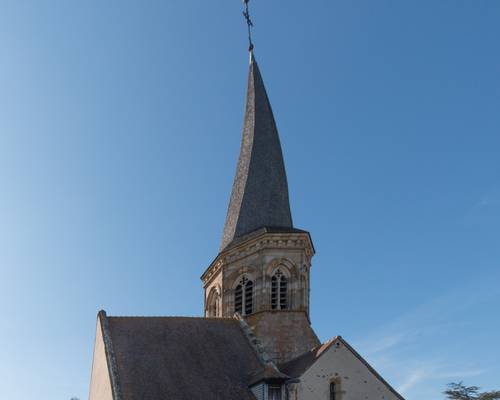
# 1
The twisted bell tower
Saint-Bonnet-de-Four
If you've got a good eye, you'll spot this particular feature from quite a long way off on the road that leads to the village of St-Bonnet-de-Four, whatever that road may be!
The only twisted bell tower in the Bourbonnais region, and even in Auvergne, the church has been particularly twisted since the end of the 19th century: in fact, the bell tower was burnt down by lightning in 1894 and rebuilt with wood that was too green and twisted. In 1978, when the town council decided to repair the roof, the Bâtiments de France insisted that it be restored to its original state: the spire has retained its twist of one eighth of a turn from left to right, accompanied by a significant overhang. The current roof is made of chestnut shingles.
The church dedicated to Saint-Bonnet has been listed as a historic monument since 26 November 1968.
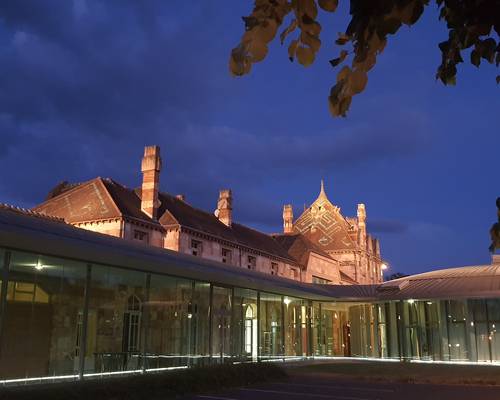
# 2
Le Pavillon du Lac
Néris-les-Bains
This particularly attractive building is the former Néris-les-Bains station, built between 1929 and 1931 to plans by architect Louis Brachet. An architectural masterpiece based on the principle of "Art Deco Regionalism", its pink and yellow sandstone and colourful glazed tiles are remarkable. Located on the Montluçon-Gouttières (Puy-de-Dôme) line, Néris-les-Bains station had a short life: eight years after the line officially opened (15 May 1931), traffic was suspended due to the Second World War. After a feverish resumption, passenger trains stopped running in 1957 and freight trains in 1969. It finally closed on 14 January 1972.
In 1975, the station was listed as a Historic Monument. Owned by the local council, it was renamed the Pavillon du Lac and used as a village hall. Following major renovation work, the new complex dedicated to weddings, receptions and exhibitions was inaugurated in 2010.
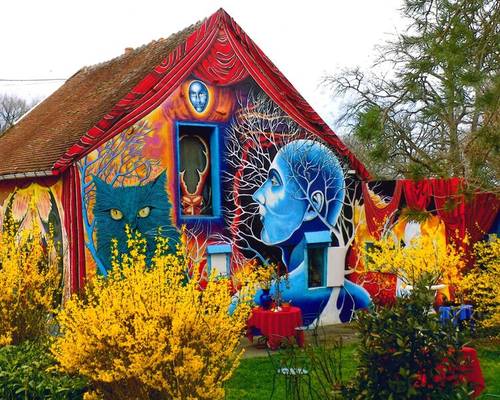
# 3
La Maison Couleur de Temps
Venas
Chop, painter or poet? Definitely both!
You only have to approach his house to be transported into a colourful, dreamlike, fabulous, symbolic world... The frescoes that cover both the interior and exterior evoke the seasons that pass and are continually renewed, like nature and life.
Chop has lived in this quiet corner of the Bourbonnais region for almost 50 years, painting and repainting his house to bring out the colours of his works and to make them change with the seasons.
On certain days, you might even come across him dressed in a costume from another era during a visit.
For information on visiting days, contact the Tourist Office.
Unusual heritage

This "impolite" little character, who sticks his tongue out at passers-by, is one of the modillions in the church of Saint-Patrocle in LA CELLE.
This late 11th/early 12th century church is dedicated to Saint-Patrocle, who lived as a hermit in La Celle before establishing a monastery in Colombier at the end of his life, where he died in 576.
The north chapel also has a kind of a hole from which the lord of the manor could have a direct view of the officiant while remaining hidden from the faithful attending the service in the nave.

This sculpture by Alain Bourgeon is located in COMMENTRY and represents the town's emblem: the meganeura monyi dragonfly, a fossil discovered at the end of the 19th century in the Commentry coalfield. This specimen was exceptional for its size: 70cm wingspan!
"More than 1,300 specimens were recorded by the entomologist and palaeontologist Charles Brongniart in 1885. Numerous scientific studies have revealed the extraordinary palaeoentomological wealth of Commentry and the remarkable conservation of its fossil insects" (source: Sylvain Charbonnier, Museum National d'Histoire Naturelle).
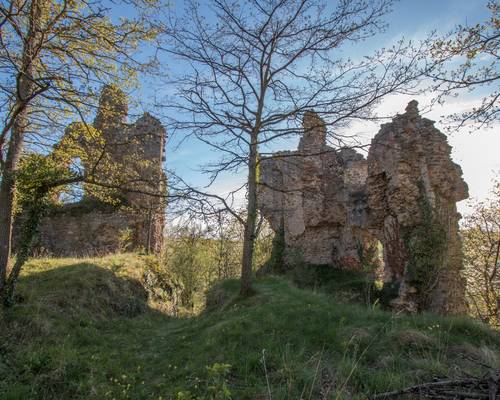
It's hard to believe that these few sections of wall are practically all that remain of the Château de MURAT!
And yet the fortress of Murat was one of the most important ducal strongholds in the Bourbonnais. It was dismantled in 1531, following the defection of the Constable.
There is a local saying that goes "Bourbon the beautiful, Murat the rich and Chantelle the strong", referring to the three fortresses of 3 medieval castellanies.
At the foot of the old castle, you can discover a spring that is said never to freeze, "Le Creux Chaud". This spring inspired the writer Jean-Charles Varennes in his book "Les fiancés du creux chaud".
The ruins are on private property. They can only be seen from the outside.
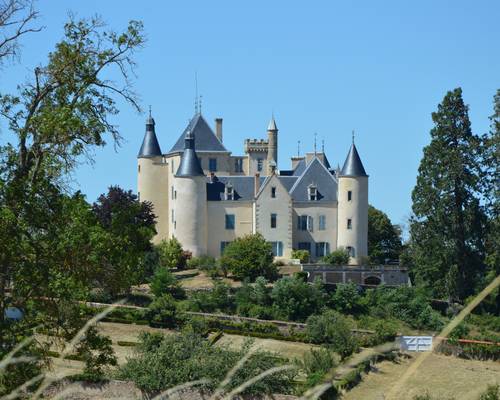
Like Sleeping Beauty's castle, Puy-Guillon castle in VERNUSSE towers skywards.
The seven-century-old citadel of Puy Guillon has stood the test of time. In 1300 Hugues de la Bâtisse was Lord of Puy-Guillon. In 1398, the Beaucaire family took possession of the castle, which remained in their possession for over two centuries. The tombstone of Jean III de Beaucaire can be seen in the church of St-Martin, near the church treasury, in the former chapel of the Virgin.
This private castle is undergoing ongoing restoration. Free access from outside, only via the path to the right of the main entrance gate, with a view of the east facade of the château and the grand staircase (work in progress).

